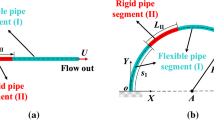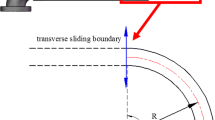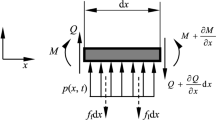Abstract
A new nonlinear model is presented for a pipe conveying fluid with an initial configuration and an extensible centerline. The proposed model is established in a local coordinate system, considering small strains but large displacements. On the basis of the Green–Lagrange strain tensor and the Euler–Bernoulli beam theory, the strain energy of the system is obtained in the derivation of the equations of motion . The partial differential equations of motion are transformed into ordinary differential equations by the differential quadrature method (DQM). Static equations and linearized dynamic equations around static solutions are given, and the dynamical characteristics are investigated. Static deformation and natural frequencies are given with different fluid conveying curved pipes. Numerical results show that semi-circular, elliptic, arc-type, and imperfect pipes do not lose stability; however, with increasing fluid velocity, these systems have static deflection. Finally, by applying the finite element absolute node coordinate method (ANCF), the numerical results of arc-type and imperfect pipes are verified in an appendix.














Similar content being viewed by others
References
Paidoussis MP (1998) Fluid–structure interactions: slender structures and axial flow, vol 1. Academic Press, New York
Whitby M, Quirke N (2007) Fluid flow in carbon nanotubes and nanopipes. Nat Nanotechnol 2(2):87–94
Ibrahim R (2010) Overview of mechanics of pipes conveying fluids-part I: fundamental studies. J Pressure Vessel Technol 132:3
Paidoussis MP, Issid N (1974) Dynamic stability of pipes conveying fluid. J Sound Vib 33(3):267–294
Semler C, Li GX, Paidoussis M (1994) The non-linear equations of motion of pipes conveying fluid. J Sound Vib 169(5):577–599
Wadham-Gagnon M, Paı M, Semler C et al (2007) Dynamics of cantilevered pipes conveying fluid part 1: nonlinear equations of three-dimensional motion. J Fluids Struct 23(4):545–567
Luczko J, Andrzej C (2017) Nonlinear three-dimensional dynamics of flexible pipes conveying fluids. J Fluids Struct 70:235–260
Wang L, Liu Z, Abdelkefi A, Wang Y, Dai H (2017) Nonlinear dynamics of cantilevered pipes conveying fluid: towards a further understanding of the effect of loose constraints. Int J Non-Linear Mech 95:19–29
Panda L, Kar R (2007) Nonlinear dynamics of a pipe conveying pulsating fluid with parametric and internal resonances. Nonlinear Dyn 49(1–2):9–30
Chang GH, Modarres-Sadeghi Y (2014) Flow-induced oscillations of a cantilevered pipe conveying fluid with base excitation. J Sound Vib 333(18):4265–4280
Yamashita K, Nishiyama N, Katsura K, Yabuno H (2021) Hopf–Hopf interactions in a spring-supported pipe conveying fluid. Mech Syst Signal Process 152:107390
Chen S-S (1972) Vibration and stability of a uniformly curved tube conveying fluid. J Acoust Soc Am 51(1B):223–232
Chen S-S, Out-of-plane vibration and stability of curved tubes conveying fluid
Misra A, Paidoussis M, Van K (1988) On the dynamics of curved pipes transporting fluid. Part I: inextensible theory. J Fluids Struct 2(3):221–244
Misra AK, Padoussis MP, Van KS (1988) On the dynamics of curved pipes transporting fluid. Part II: extensible theory. J Fluids Struct 2(3):245–261
Jung D, Chung J (2008) In-plane and out-of-plane motions of an extensible semi-circular pipe conveying fluid. J Sound Vib 311(1–2):408–420
Ni Q, Tang M, Wang Y, Wang L (2014) In-plane and out-of-plane dynamics of a curved pipe conveying pulsating fluid. Nonlinear Dyn 75(3):603–619
Czerwinski A, Luczko J (2021) Nonlinear vibrations of planar curved pipes conveying fluid. J Sound Vib 501:116054
Sinir BG (2010) Bifurcation and chaos of slightly curved pipes. Math Comput Appl 15(3):490–502
Wang L, Dai H, Qian Q (2012) Dynamics of simply supported fluid-conveying pipes with geometric imperfections. J Fluids Struct 29:97–106
Hu Y-J, Zhu W (2018) Vibration analysis of a fluid-conveying curved pipe with an arbitrary undeformed configuration. Appl Math Model 64:624–642
Dehrouyeh-Semnani AM, Nikkhah-Bahrami M, Yazdi MRH (2017) On nonlinear stability of fluid-conveying imperfect micropipes. Int J Eng Sci 120:254–271
Zhou K, Ni Q, Chen W, Dai H, Hagedorn P, Wang L (2021) Static equilibrium configuration and nonlinear dynamics of slightly curved cantilevered pipe conveying fluid. J Sound Vib 490:115711
Luczko J, Czerwinski A (2019) Three-dimensional dynamics of curved pipes conveying fluid. J Fluids Struct 91:102704
Tang M, Ni Q, Wang L, Luo Y, Wang Y (2014) Nonlinear modeling and size-dependent vibration analysis of curved microtubes conveying fluid based on modified couple stress theory. Int J Eng Sci 84:1–10
Wen H-B, Yang Y-R, Li Y-D, Huang Y (2018) Analysis on a kinetic theoretical model of the straight-curved pipe conveying fluid. Int J Acoust Vib 23:240–253
Dogruoglu AN, Komurcu S (2019) Nonlinear mixed finite element formulations for the analysis of planar curved beams. Comput Struct 222:63–81
Timoshenko SP, Gere JM (2009) Theory of elastic stability. Courier Corporation, North Chelmsford
Thompson JMT, Hunt GW (1973) A general theory of elastic stability. Wiley, New York
Ni Q, Zhang Z, Wang L (2011) Application of the differential transformation method to vibration analysis of pipes conveying fluid. Appl Math Comput 217(16):7028–7038
Berzeri M, Shabana A (2000) Development of simple models for the elastic forces in the absolute nodal co-ordinate formulation. J Sound Vib 235(4):539–565
Acknowledgements
The research was partially supported by the National Natural Science Foundation of China (Grant Numbers 11872043), and the Opening Project of Sichuan Province University Key Laboratory of Bridge Non-destruction Detecting and Engineering Computing (Grant Numbers 2016QZJ03), and Fund Project of Sichuan University of Science and Engineering in hit-haunting for talents (Grant Numbers 2016RCL31 and 2018RCL11), and Key projects of Department of Education of Sichuan Province (Grant Numbers 18ZA0353), and Zigong Science and Technology Program (Grant Numbers 2020YGJC03). The authors thank the anonymous reviewers for their helpful suggestions.
Author information
Authors and Affiliations
Corresponding author
Additional information
Publisher's Note
Springer Nature remains neutral with regard to jurisdictional claims in published maps and institutional affiliations.
Appendix
Appendix
To get reliable numerical results, the credibility of the present model for these pipes needs to be verified. Comparison is completed employing the so-called absolute nodal coordinate formulation (ANCF) [31]. In this section, the authors only select two types of pipe models for comparison. The first type is arc-type fluid-conveying pipes with the parameters \(\varphi = {40^o},{A_1} = 0.0,R = 1.462,\Pi \mathrm{{ = }}2.5 \times {10^4}\times {L^2}\). Figure 15a, b show the comparison of the natural frequencies and static displacement of arc-type pipe using the present theory and ANCF.The numerical results show high consistency.
In addition, the second pipe system which is the imperfect pipe with the imperfection function as in (56) is analyzed in two modeling theories with \(\Pi \mathrm{{ = }}1000.0,\beta = 0.50,A_1=0.1\). Using these system parameters, the natural frequencies and static equilibrium of the pipe are shown in Fig. 16. Clearly, from Figure 16a, b, it can be seen that the results of the present theory agree very well with those of ANCF. Comparison of numerical results based on two types of pipe models demonstrates that the present model is reliable.
Rights and permissions
About this article
Cite this article
Yun-dong, L., Ze-gang, S. Analysis of Planar Motion for Curved Pipe Conveying Fluid with Different Types of Initial Configuration. J. Vib. Eng. Technol. 10, 2033–2048 (2022). https://doi.org/10.1007/s42417-021-00403-w
Received:
Revised:
Accepted:
Published:
Issue Date:
DOI: https://doi.org/10.1007/s42417-021-00403-w






